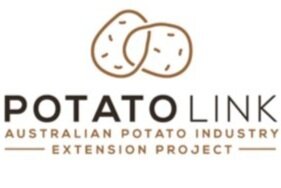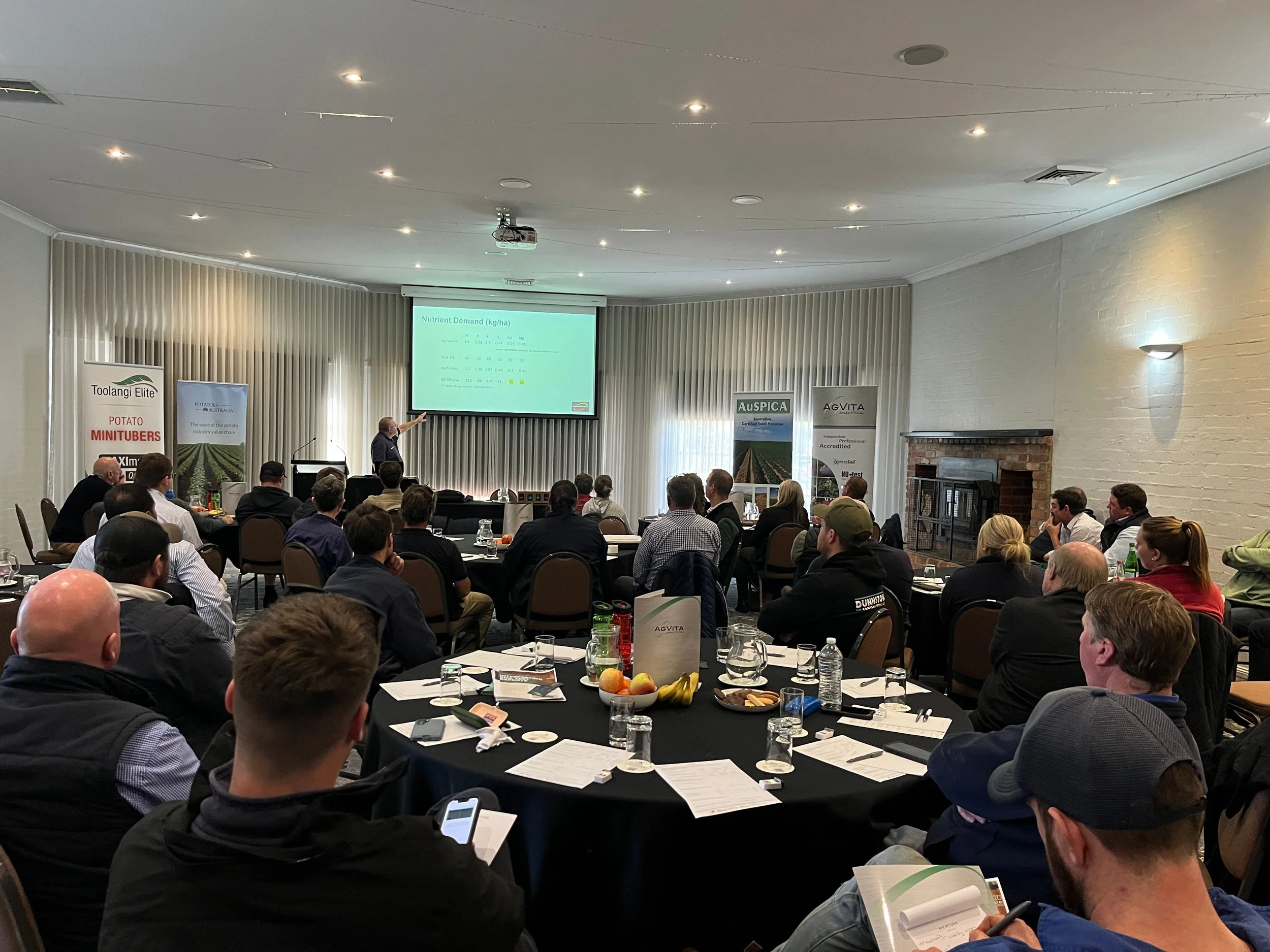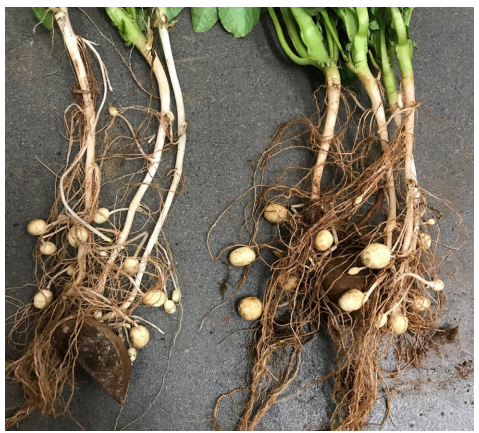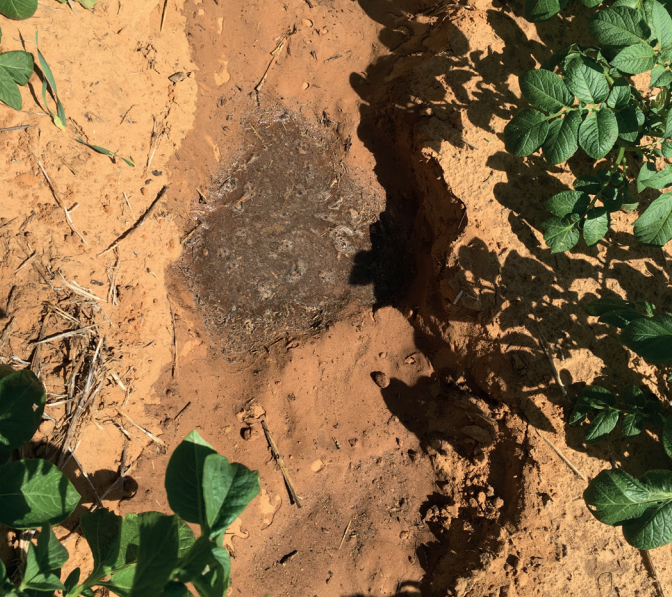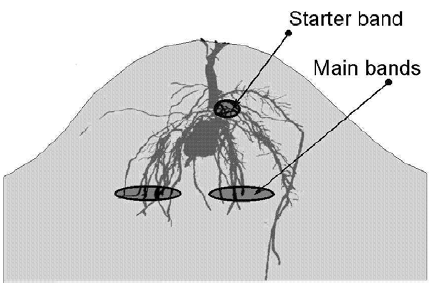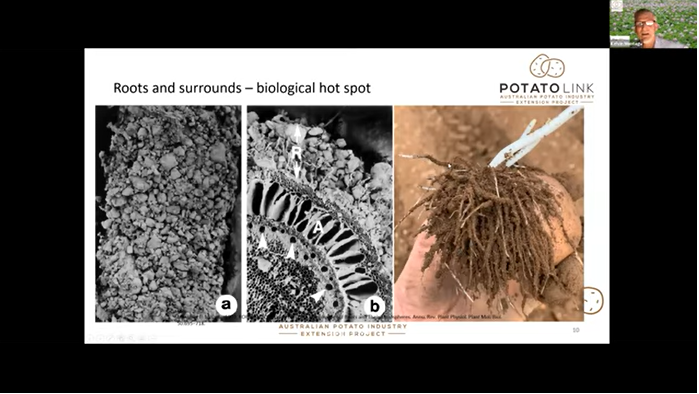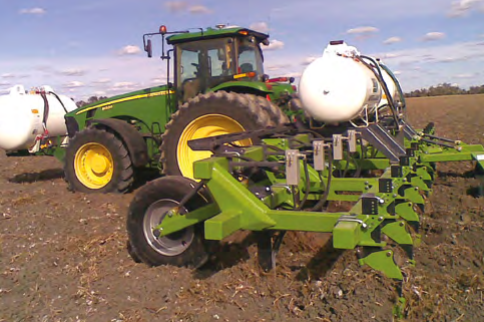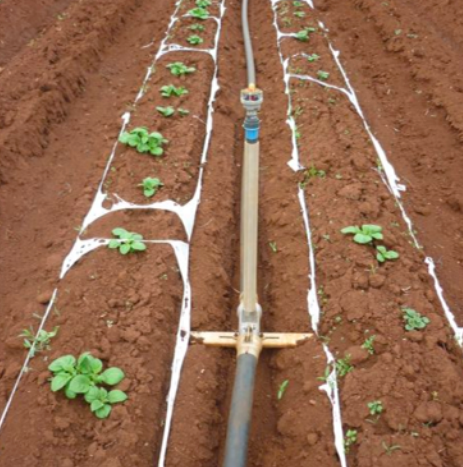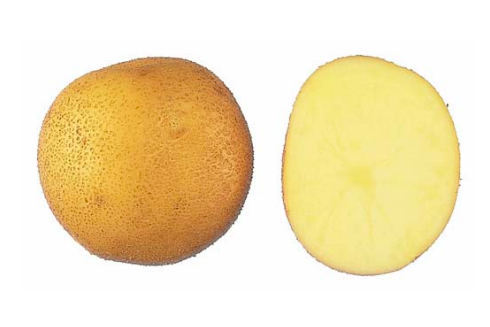
Nutrition Management

A PotatoLink demo with grower Coby Badcock tested four fertiliser strategies on a Tasmanian crop, comparing high-input vs sap-guided approaches. The results offer insights into nutrient timing, efficiency, and cost-effectiveness—proving that more fertiliser doesn’t always mean better yield.
A recent PotatoLink demonstration trial at Springbank, Vic, investigated the impact of farm practices on the effectiveness of biologicals, including the application of fungicides, the influence of soil nutrient availability, and fertiliser applications. In Issue 10 of PotatoLink magazine you will find all the details of the trial as well as the results.
Understanding and managing the interacting components of soil health - physical, biological and chemical factors - is essential to create robust and productive soils that are able to sustain commercial potato production. This PotatoLink magazine article examines some aspects of soil physical properties and how they impact agricultural practice (and how agricultural practices impact soil physical properties).
PotatoLink held a research and development forum in Adelaide on 5 June 2023. The seven speakers covered a range of topics including diseases, irrigation, monitoring technology and more. Below are recordings of the presentations given on the day.
Three successive La Niña seasons have left prime potato growing areas waterlogged. Challenges for growers are evident at every stage, from managing seed, planting, crop management and storage. Paulette Baumbartl covers all the key points in this article in Issue 8 of PotatoLink magazine.
Knowing what your plants need and when is crucial to getting the most out of your crop. This factsheet covers the importance of soil tests, in-season tissue testing, how nutrients interact with each other and fertiliser application methods.
In Issue 06 of PotatoLink magazine, Ryan Hall looks at the accessibility and mobility of technology available to growers in the form of drones, remote sensing and smartphone apps.
Potato plants take up large quantities of potassium with peak daily uptake reaching over 4 kg/ha/day. Supplying potassium is most important during stolon and tuber initiation, although maximum uptake occurs during tuber bulking. This PotatoLink magazine article includes information on supplying potassium to crops and how potassium has helped Canowindra, NSW potatoes.
Magnesium (Mg) is essential to plants. It is strongly involved in photosynthesis and transporting carbohydrates from leaves to roots, which is particularly important for tuber development. Yet, it may be overlooked within fertiliser programs focused on N, P and K. Read about the Mg mini trial in this PotatoLink magazine article.
This Soil Wealth & Integrated Crop Protection case study examines the role of phosphorus availability and uptake in a potato crop throughout the growing season. It shares the results of a trial in north-west Tasmania of a new liquid phosphorus fertiliser applied to processing potatoes in P-fixing soils.
The first soil biology masterclass was delivered by Dr. Kelvin Montagu, looking at the linkage between key soil functions and soil biology, and the interactions between plant roots and soil biology.
Adrian James covers the current state of play of carbon in agriculture, carbon neutral farming and the use of farm carbon calculators. In addition he explores the opportunities in farm carbon offsets.
Watch this webinar presented by Frank Mulcahy to learn how soil mapping (EM38) can assist potato growers with better yields.
Catch up on Day 2 of the Australian Potato R&D Forum 2021, which focused on soil health and disease management.
The diseases caused by Spongospora subterranea (tuber powdery scab and root hyperplasia) can cause significant yield and quality loss. Not all soils are equally susceptible to this disease. This 2020 report determined factors that resulted in Spongospora suppressive soils in New Zealand.
Explore the impact of hydrophobic soils on potato production and options for growers to assist with their management to improve potato yields.
This Hort Innovation report covers the current state of knowledge of soil health, with the use of over 220 references from both Australian and international sources. This report also covers various workshops media articles, videos and a factsheet associated with soil health in potato production.
This Serve-Ag project ran from 2016 to 2020 to assess groundwater quality in areas of potato production in South Australia (where groundwater quality is most variable) and investigated how regional and seasonal water-quality variability impacts on potato production and quality.
Using modern sensor technology high levels of data can now be gathered from crops as they grow. This 2016 report explores how this data can be assessed to gain a greater understanding of productivity in different parts of a paddock. This project is a crucial step towards site specific crop management for the potato industry.
Crops grown on Kransnozems (also known as ferrosols) often had high levels of phosphorus fertiliser applied. This 2002 report explores different ways of applying phosphorus fertiliser to a crop in order to reduce fertiliser use. Different Fertiliser forms and interactions with irrigation were applied over the three year project.
Organic Sources of Nitrogen
Understanding and managing the interacting components of soil health - physical, biological and chemical factors - is essential to create robust and productive soils that are able to sustain commercial potato production. This PotatoLink magazine article examines some aspects of soil physical properties and how they impact agricultural practice (and how agricultural practices impact soil physical properties).
The world may be easing its way into post-pandemic normality, however latest market research shows that this will have limited impact on the historically high prices of nitrogen and imported fertilisers for Australian farmers. This PotatoLink magazine article provides tips on getting the most nitrogen out of your legume cover crop.
In this webinar Dr Kelvin Montagu and Peter O’Brien discussed the principles of using legumes as an alternative nitrogen source, the importance of legume inoculants and considerations for best results in potatoes.
In this Soil Wealth & Integrated Crop Protection (SWICP) webinar recording, you’ll hear from Kelvin Montagu, Doris Blaesing and Marc Hinderager about management options for the vegetable industry covering topics such as adding nitrogen using legumes, optimising fertiliser practices, reducing nitrogen fertiliser losses, soil testing and crop monitoring.
Watch this panel discussion and the last soil biology masterclass with potato growers across Australia and see many of your questions answered.
The third soil biology masterclass was delivered by PotatoLink team member Marc Hinderager, looking into nitrogen availability in potato and cover crops, and its impact on soil biology.
The 2-hour masterclass aims to provide potato growers and advisers with the understanding they need to improve soil biology, potato yields and their bottom line.
Anhydrous ammonia has long been used as a preplant and side dressing fertiliser in the cotton and grain industries. It results in a high retention of nitrogen in the soil, reduced leaching of nitrates through the soil and yield increases in various crops. However, it needs to be treated with care as it can cause injury to farm workers.
A three-year project in Tasmania was conducted on the potential benefits of using degradable polyethylene films in potato crops. This 2013 report found there was limited benefit to nitrogen fertiliser savings and yield but instead may allow for early harvest and some water saving.
This 2003 report proposes guidelines on site-specific nitrogen management using ‘real-time’ monitoring tools. By looking at plant, stem and tuber numbers, yield, tuber size and quality and previous paddock history the impact of nitrogen on a seed crop was determined.
Between 1995-2001 specific gravity of potatoes from Koo Wee Rup declined substantially. Possible causes of specific gravity loss were explored in this report. Cultivars, crop production management and climate conditions were all investigated.
Testing & Interpretation
A recent PotatoLink demonstration trial at Springbank, Vic, investigated the impact of farm practices on the effectiveness of biologicals, including the application of fungicides, the influence of soil nutrient availability, and fertiliser applications. In Issue 10 of PotatoLink magazine you will find all the details of the trial as well as the results.
Stephanie Tabone (PotatoLink and AHR) talks to NSW's regional representative Marc Hingerager about his 2022 magnesium demonstration trial in Canowindra NSW. They discuss the trial, the results and why magnesium is important.
Stephanie Tabone (PotatoLink and AHR) talks to NSW's regional representative Marc Hingerager about his 2022 Potassium demonstration trial in Canowindra NSW. They discuss the trial, the results and why potassium is important.
The correct interpretation of the report, is vital to ensure fertiliser applications are adequate to supply crop requirements. This factsheet covers important considerations while soil sampling and testing, the common parameters tested and which nutrients can be reported.
Knowing what your plants need and when is crucial to getting the most out of your crop. This factsheet covers the importance of soil tests, in-season tissue testing, how nutrients interact with each other and fertiliser application methods.
Ensuring plants get the right amount of water when they need it is essential to produce a great crop. In this factsheet, Dr Jenny Ekman covers water stress, waterlogging and how to make sure your potatoes are getting the right amount of water.
Petiole sampling and analysis is an effective and simple way to determine the nutrient status of a crop, including diagnosing any deficiencies or toxicities in potato plants. Like any analyses, getting the sampling right is the first step. In this PotatoLink magazine article, learn when to sample, how to sample and how to handle samples.
Developed by SARDI (South Australian Research and Development Institute), PREDICTA Pt is a commercial DNA testing service that can identify which pathogens are in the soil or skin of seed tubers.
In Issue 05 of PotatoLink magazine, Ryan Hall and Jenny Ekman from the PotatoLink team report on PREDICTA Pt including a 5-year case study describing its use in monitoring powdery scab and rhizoctonia on a commercial farm.
Potato grower, Darren Long and Dr Kelvin Montagu talk all things cover crops and discuss how they can assist with building up soil health – including practical tips & tricks!
PotatoLink team member Frank Mulcahy discusses historical mapping and crop conformance, redictive crop modelling, pioneering Variable Rate Irrigation (VRI) on farm and results from finished 2 year project on spatial variability in potato crops.
Albert Schirring covers the role of biologicals in soil health and the opportunities in enhancing crop productivity in potatoes.
Dom Cavallaro (Stoller), Ian Simpson (Mitolo), Nigel Crump (AuSPICA) and Peter Philp (PotatoLink) discuss seed management, quality and timing of supply and how quality seed is the foundation of profitable potato production.
With information from 48 peer-reviewed studies this review provides the most up to date understanding of potassium nutrition for potatoes.
Plant analysis is used as a tool to fine tune the nutrition of crops. The nutrient status of plants or parts of plants can be determined directly via laboratory analysis or estimated via in-field testing, while the overall health and nutrient status of a crop can be assessed via non-destructive sensing technologies.
